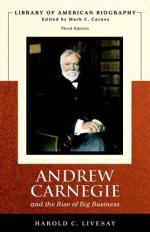|
This section contains 549 words (approx. 2 pages at 400 words per page) |

|
Triumph and Tragedy Summary and Analysis
Frick's chairmanship of the Carnegie Company marks a difficult period in its history starting with the Homestead strike in 1892 and a four year depression from 1893. When prosperity returns, the Carnegie business thrives but the damage to his personal reputation from the strike never heals. Frick's first acquisition is Duquesne Steel, which is the most modern steel mill and keeps the Carnegie Company at the forefront. Duquesne has labor and capital problems however from its opening in 1889. Carnegie claims at the competitor's opening that it lacks "homogeneity" that is false and meaningless but gets Duquesne off to a bad start with the idea of having a defect.
Ironically, the homogeneity claim creates cost savings by moving hot ingots directly from mold to roller without reheating and is implemented at both ET and Homestead. After Duquesn'se acquisition for $1 million...
(read more from the Triumph and Tragedy Summary)
|
This section contains 549 words (approx. 2 pages at 400 words per page) |

|




